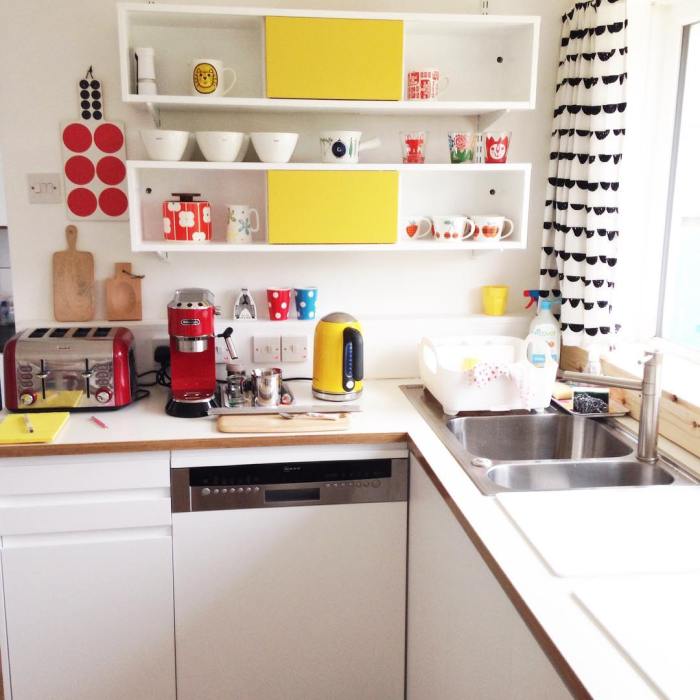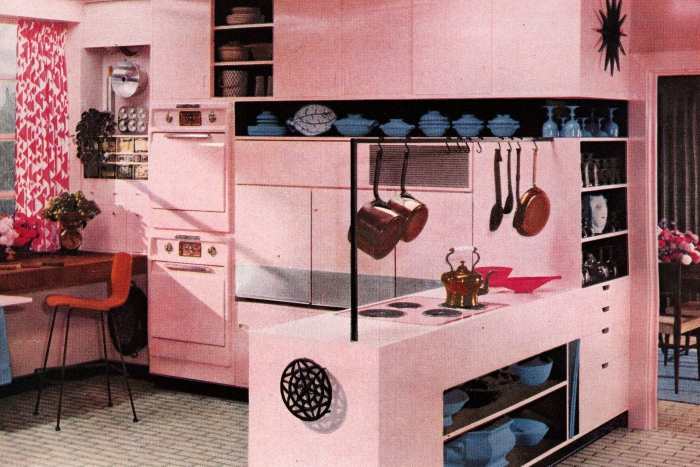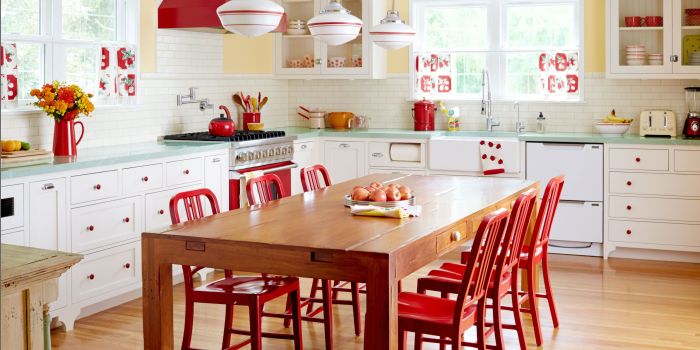Step back in time with a journey into the captivating world of retro kitchen design. This isn’t simply about nostalgia; it’s about understanding the interplay of color palettes, material choices, and design elements that define this uniquely stylish aesthetic. We’ll explore the evolution of retro kitchen styles – from the streamlined elegance of mid-century modern to the vibrant energy of 1950s diners and the rustic charm of vintage farmhouses – uncovering the scientific principles behind their enduring appeal.
The careful selection of materials, from the warmth of wood to the gleam of chrome, isn’t arbitrary; it’s a calculated approach to creating a space that is both visually stunning and functionally efficient. Prepare to be inspired as we delve into the details that transform a kitchen into a timeless masterpiece.
This exploration will cover the key characteristics defining retro kitchens with classic elements, comparing and contrasting various styles. We will analyze the impact of material selection, such as wood, metal, and laminate, on the overall aesthetic, and examine the role of countertops and backsplashes in achieving the desired look. Furthermore, the integration of retro-styled appliances and lighting fixtures, decorative accents, and the creation of a cohesive design that balances retro charm with modern functionality will be meticulously examined.
Finally, illustrative examples will showcase the diverse possibilities within this captivating design realm.
Defining “Retro Kitchen Decor with a Classic Touch”
Retro kitchen decor with a classic touch represents a stylistic blend, drawing inspiration from various eras while maintaining a timeless appeal. It’s not simply a replication of a specific period but a curated selection of design elements that evoke nostalgia and sophistication. This style prioritizes quality materials, craftsmanship, and enduring design principles, resulting in kitchens that are both visually striking and functionally efficient.
The key lies in the thoughtful juxtaposition of elements from different periods, creating a cohesive and uniquely personal space.
The core characteristics defining this style include the use of durable materials like stainless steel, enamel, and natural wood; the incorporation of classic design motifs such as subway tile backsplashes and Shaker-style cabinetry; and a balanced color palette that avoids being overly trendy. A sense of warmth and inviting character is usually present, often achieved through the strategic use of lighting and carefully chosen accessories.
Retro Kitchen Styles: A Comparative Analysis
Mid-century modern, 1950s diner, and vintage farmhouse styles all contribute to the broader “retro kitchen with a classic touch” theme, yet each offers a distinct aesthetic. Mid-century modern, popularized in the 1950s and 60s, emphasizes clean lines, functionality, and a focus on natural materials such as teak and walnut. The 1950s diner style, on the other hand, leans towards bold colors, chrome accents, and a playful, energetic atmosphere reminiscent of classic American diners.
Finally, the vintage farmhouse style evokes a sense of rustic charm, incorporating distressed wood, vintage hardware, and a palette of muted, natural tones. While different, all three styles share a commitment to quality and enduring design, making them suitable components of a broader retro-classic kitchen.
Color Palettes in Retro Kitchen Decor
Color plays a crucial role in establishing the desired mood and aesthetic. The choice of color palette significantly impacts the overall feel of the retro kitchen, whether it evokes the vibrancy of a 1950s diner or the calming neutrality of a vintage farmhouse. Careful consideration should be given to how colors interact with natural light and the overall spatial dimensions of the kitchen.
| Color Name | Hex Code | Associated Era | Example Use in a Retro Kitchen |
|---|---|---|---|
| Avocado Green | #50804B | 1970s | Cabinetry, appliances, or accent walls |
| Daisy Yellow | #FFF8DC | 1950s | Walls, countertops, or as an accent color with darker cabinetry |
| Buttercream | #FDF5E6 | Vintage Farmhouse | Cabinetry, walls, or as a base color for a softer, warmer feel |
| Coral Pink | #F08080 | 1950s | Accent pieces, bar stools, or as a feature wall |
Essential Elements of Retro Kitchen Design
The retro kitchen, with its classic touch, represents a fascinating blend of nostalgia and modern functionality. This style evokes a sense of simpler times while incorporating elements that enhance contemporary living. Understanding the key design elements allows for the creation of a space that is both aesthetically pleasing and practical.
Material Selection in Retro Kitchen Design
The choice of materials significantly impacts the overall aesthetic of a retro kitchen. The strategic use of wood, metal, and laminate creates a specific visual narrative. Warm, natural wood, often seen in cabinetry and flooring, provides a sense of comfort and familiarity, reminiscent of kitchens from mid-century designs. Metal accents, such as chrome or brushed nickel on appliances, hardware, and lighting fixtures, add a touch of sleekness and sophistication, reflecting the industrial design influences prevalent in retro aesthetics.
Laminate countertops, available in a wide array of colors and patterns, offer durability and affordability, contributing to the overall retro feel while providing a practical, easy-to-clean surface. The interplay between these materials creates a balanced and visually engaging space.
Countertop Material Impact on Retro Kitchen Aesthetics
Countertop selection plays a pivotal role in defining the retro kitchen’s character. Butcher block countertops, made from solid wood, offer a rustic charm and a warm, tactile experience, aligning perfectly with the mid-century modern aesthetic. Their inherent durability makes them a practical choice for heavy use. Conversely, Formica countertops, a hallmark of retro design, offer a wide range of colors and patterns, allowing for customization and the creation of a truly unique look.
The glossy, smooth surface of Formica contrasts beautifully with the natural wood tones often found in retro kitchens, adding a vibrant and playful element. The choice between these materials—or a combination thereof—directly influences the overall mood and style of the space.
Backsplash Design Options for a Retro Kitchen
The backsplash is a crucial design element that can significantly enhance the retro aesthetic. Three distinct backsplash options, each showcasing different materials and patterns, can achieve a variety of looks:
- Subway Tile Backsplash: This classic choice features small, rectangular tiles arranged in a traditional running bond pattern. Using white or pastel-colored ceramic tiles evokes a clean, timeless aesthetic, common in many retro kitchens. The simplicity of the pattern allows other elements in the kitchen to stand out.
- Geometric Patterned Tile Backsplash: This option utilizes larger tiles with geometric patterns, such as hexagons or arabesques, in bold colors or contrasting shades. This approach adds a more playful and vibrant touch, capturing the energetic spirit of retro design. Materials like ceramic or even terrazzo tiles can be used to achieve this look.
- Metal Backsplash: A stainless steel or copper backsplash provides a sleek, industrial-chic look that complements the retro style, particularly when paired with metal appliances. This option is durable and easy to clean, offering a modern twist on a classic aesthetic. The reflective surface can also brighten the space.
Appliances and Fixtures
The heart of any retro kitchen with a classic touch lies in its appliances and fixtures. These elements aren’t merely functional; they are integral to establishing the desired aesthetic, blending the nostalgic charm of bygone eras with the practicality of modern living. Careful selection of these components is crucial for achieving a cohesive and visually appealing space. The interplay of form and function creates a kitchen that is both beautiful and efficient.The successful integration of retro appliances and fixtures requires a nuanced understanding of design principles and material choices.
The interplay of colors, shapes, and materials will determine the overall atmosphere, ranging from a vibrant 1950s diner aesthetic to a more subdued and elegant mid-century modern feel. The following sections will delve into specific examples and considerations for each category.
Retro-Styled Appliances
Retro-styled appliances evoke a sense of nostalgia and sophistication. Their designs often feature rounded edges, pastel colors, and chrome accents, reminiscent of the mid-20th century. Examples include refrigerators with curved doors and integrated handles, ovens with sleek control panels and analog clocks, and toasters with vibrant colors and chrome details. These appliances are not merely decorative; many offer modern functionalities such as energy-efficient operation and advanced cooking features, seamlessly blending vintage aesthetics with contemporary technology.
For instance, a refrigerator might boast a retro-inspired exterior but include features like internal LED lighting and adjustable temperature settings.
Vintage-Inspired Lighting Fixtures
Lighting fixtures play a significant role in setting the mood and ambiance of a retro kitchen. Vintage-inspired lighting often incorporates elements such as globe-shaped shades, metallic finishes (brass, chrome, or copper), and pendant lights. Pendant lights, in particular, can be strategically placed above kitchen islands or dining areas to create a focal point. The use of glass shades can diffuse light softly, while metallic accents add a touch of industrial chic.
Consider using Edison-style bulbs to further enhance the vintage aesthetic; these bulbs offer a warm, yellowish glow reminiscent of older lighting technologies. The choice of lighting fixture should complement the overall color scheme and style of the kitchen, creating a harmonious and well-lit space.
Retro Kitchen Sinks and Faucets
Retro kitchen sinks and faucets offer a wide array of stylistic choices. Farmhouse sinks, characterized by their large, deep basins and apron-front design, are a popular choice for their rustic charm and practicality. These sinks often pair well with gooseneck faucets, which feature a high-arched spout and a lever handle. Alternatively, a more streamlined, integrated sink with a single-lever faucet can achieve a cleaner, more modern retro look.
Materials such as stainless steel, enamel, and even copper can be used to achieve a variety of aesthetic effects. The choice between a farmhouse sink and a more integrated design will depend on the overall size and layout of the kitchen, as well as the desired aesthetic.
Retro Appliance Brands
Several appliance brands are known for their commitment to producing retro-styled products that capture the essence of mid-century design while incorporating modern technology. These brands often focus on quality materials, durable construction, and attention to detail.
- Big Chill: Known for their wide range of retro-styled refrigerators, ranges, and other appliances in a variety of vibrant colors.
- Smeg: Offers a stylish collection of retro appliances, including refrigerators, ovens, and toasters, often featuring pastel colors and iconic designs.
- Elmira Stove Works: Specializes in producing high-end, retro-styled ranges and ovens with a focus on classic American design.
- GE Profile Series: While not exclusively retro, GE offers several models within their Profile Series that incorporate retro design elements.
- Fisher & Paykel: Offers a selection of appliances with a clean, minimalist aesthetic that can complement a retro kitchen with a classic touch.
Decorative Accents and Accessories

Retro kitchen decor with a classic touch relies heavily on carefully chosen decorative accents to evoke a sense of nostalgia and sophistication. The right accessories can transform a simple kitchen into a vibrant and stylish space, reflecting the era’s design principles while maintaining a timeless appeal. The interplay of color, pattern, and texture is key to achieving this balance.
Patterned Wallpaper and Tiles
The strategic use of patterned wallpaper or tiles is a cornerstone of retro kitchen design. The mid-century modern era, for instance, saw a surge in popularity of geometric patterns, floral motifs, and bold color combinations. These patterns, often found on kitchen backsplashes or as feature walls, immediately establish a retro aesthetic. Scientifically, the human eye is naturally drawn to patterns; their repetition creates a sense of rhythm and visual interest, enhancing the overall appeal of the space.
For example, a kitchen featuring a vibrant geometric tiled backsplash in shades of turquoise and orange, reminiscent of 1950s diner aesthetics, would instantly evoke a retro feel. Similarly, a wallpaper with a delicate floral pattern in pastel shades could create a softer, more romantic retro ambiance. The choice of pattern should be guided by the overall color scheme and desired level of boldness.
Vintage-Inspired Artwork and Textiles
Incorporating vintage-inspired artwork and textiles adds another layer of depth and character to the retro kitchen. Think about framed prints of vintage advertisements featuring classic kitchen appliances or iconic imagery from the 1950s and 60s. These pieces serve as visual anchors, reinforcing the retro theme. Textiles, such as vintage-inspired dish towels, placemats, or even a patterned runner for the kitchen table, can add textural interest and contribute to the overall aesthetic.
The psychological impact of visual stimuli is well-documented; the carefully chosen artwork and textiles create a specific mood and evoke a sense of nostalgia, contributing to a positive and engaging kitchen environment. For instance, a set of vintage-style tea towels featuring retro-inspired fruit motifs would complement a kitchen with a similar color palette.
Open Shelving and its Enhancement of Retro Aesthetics
Open shelving is a design element that perfectly complements the retro aesthetic. It allows for the display of vintage-inspired cookware, crockery, and decorative objects, further enhancing the retro theme. The open shelving creates a sense of visual lightness and airiness, preventing the kitchen from feeling cluttered, even with a large number of displayed items. Furthermore, the strategic placement of items on open shelves allows for the creation of visual focal points, drawing the eye to specific areas and enhancing the overall design.
Imagine a set of enamelware bowls and vintage canisters displayed neatly on open shelves, creating a charming and functional display that speaks to the retro style. The arrangement itself becomes a decorative element, contributing to the overall aesthetic appeal.
Five Decorative Accessories to Enhance Retro Kitchen Charm
The selection of decorative accessories is crucial in perfecting the retro aesthetic. These items, carefully chosen, add the finishing touches and create a cohesive and stylish space.
- A vintage-style clock: A wall clock with a distinctive retro design, perhaps featuring a bold color or a unique typeface, adds a functional and decorative element.
- A retro-inspired utensil holder: A ceramic or metal utensil holder with a distinctive shape and color scheme, echoing the overall kitchen design.
- A collection of vintage-inspired canisters: These can be used to store dry goods, adding both functionality and visual appeal.
- A vintage-style enamelware tray: This serves as a decorative piece and a practical serving tray, showcasing a classic material often associated with retro kitchens.
- A set of retro-inspired teacups and saucers: Displayed on open shelving or used for serving tea, these add a touch of elegance and nostalgia.
Creating a Cohesive Retro Kitchen Design

A successful retro kitchen design hinges on the delicate balance between nostalgic charm and modern functionality. The goal is not to create a museum piece, but a livable, comfortable space that reflects personal style while incorporating the best of both eras. This requires careful consideration of material choices, appliance selection, and the strategic placement of decorative elements.The harmonious integration of retro aesthetics and contemporary conveniences is crucial.
Retro style often prioritizes form over function, a characteristic that modern design actively counters. Successfully navigating this requires thoughtful compromise. For instance, while vintage-style cabinetry might lack the internal organization of modern designs, supplementing with smart storage solutions like pull-out shelves or drawer dividers can bridge the gap. Similarly, integrating energy-efficient appliances, such as a modern induction cooktop housed within a retro-styled range hood, blends functionality with aesthetic appeal.
Balancing Retro Elements with Modern Conveniences
Effective integration involves a strategic approach. Prioritize core retro features—think classic subway tiles, a bold color palette, or iconic appliance shapes—and then subtly introduce modern elements that enhance functionality without compromising the overall aesthetic. For example, a sleek, stainless steel refrigerator can be seamlessly incorporated into a retro-inspired kitchen by choosing a model with a panel-ready front that can be customized to match the cabinetry.
Modern smart appliances can also be strategically concealed or styled to fit the retro theme.
Incorporating Personal Touches
Personalization is key to creating a truly unique retro kitchen. Consider incorporating family heirlooms, vintage artwork, or cherished collectibles to add character and warmth. A grandmother’s antique mixing bowl displayed on an open shelf, a collection of vintage cookbooks stacked neatly on a countertop, or framed family photos displayed in a retro-styled frame can all infuse the space with personal history and sentimentality.
The key is to curate items that evoke positive memories and reflect the homeowner’s personality, making the kitchen feel uniquely their own. For example, a collection of vintage enamelware could be displayed on open shelving, adding a splash of color and reflecting a personal passion for collecting.
Selecting Appropriate Flooring for a Retro Kitchen
Floor selection significantly impacts the overall aesthetic and functionality of a retro kitchen. Materials like vinyl in classic patterns (think black and white checkerboard or geometric designs) evoke a strong retro feel while offering durability and easy maintenance. Similarly, ceramic tiles, especially in classic subway or hexagonal shapes, can create a timeless and stylish look. For a more luxurious feel, consider using natural stone, such as terrazzo, which offers a unique pattern and a durable surface.
The choice will depend on budget, maintenance preferences, and the desired level of authenticity. The key is to select a material that complements the overall design scheme and provides a comfortable and practical surface.
Sample Retro Kitchen Floor Plan
The following floor plan Artikels a compact yet functional retro kitchen design:
- Layout: A galley-style kitchen with a L-shaped configuration maximizes space efficiency.
- Key Features:
- Appliances: A freestanding retro-style refrigerator, a vintage-inspired range with a modern induction cooktop, and a built-in dishwasher discreetly hidden behind cabinetry.
- Cabinets: Upper cabinets with glass-front doors to display vintage glassware and cookbooks; lower cabinets with ample storage space and pull-out shelves for efficient organization.
- Countertops: Butcher block countertops provide a warm, tactile surface and complement the retro aesthetic.
- Backsplash: Classic white subway tiles add a timeless touch.
- Flooring: Black and white checkerboard vinyl flooring provides a bold retro statement.
- Lighting: Pendant lights above the island and under-cabinet lighting provide ample illumination.
- Sink: An apron-front farmhouse sink adds a touch of rustic charm.
Illustrative Examples of Retro Kitchens

Retro kitchen design, with its blend of nostalgic charm and modern functionality, offers a fascinating exploration of stylistic choices. The following examples showcase the versatility of this approach, demonstrating how different color palettes, materials, and lighting schemes can create distinct atmospheres while adhering to the core principles of retro design. Each example incorporates a unique classic touch, reflecting the enduring appeal of timeless design elements.
1950s Diner-Inspired Kitchen
This design evokes the vibrant energy of a classic American diner. The color scheme is bold and playful, featuring a combination of cherry red, creamy yellow, and mint green. The walls are painted a cheerful mint green, acting as a calming backdrop to the more saturated colors. The cabinetry is a rich cherry red, providing a strong visual anchor.
The countertops are a creamy yellow laminate, echoing the retro aesthetic. Materials include Formica countertops, which were highly popular in the mid-20th century, and chrome accents on appliances and cabinet hardware. The classic touch lies in the use of a vintage-style checkered floor tile, adding a playful element of nostalgia. The lighting scheme is crucial; a combination of bright, overhead fluorescent lighting—reminiscent of diner lighting—is balanced with warmer, softer lighting from pendant lamps above the island or breakfast bar.
This layered approach provides both functional task lighting and a cozy ambiance. The contrast between the bright overhead lights and the softer, warmer pendants creates a dynamic and inviting space.
Mid-Century Modern Kitchen with Scandinavian Influence
This kitchen embraces the clean lines and minimalist aesthetic of mid-century modern design, infused with the light and airy feel of Scandinavian style. The color palette is predominantly neutral, utilizing shades of white, beige, and light grey. Natural materials play a significant role: light oak cabinetry provides warmth, while a butcher block countertop adds both functionality and visual texture.
The backsplash features simple, white subway tiles, a classic choice that complements the overall clean aesthetic. The classic touch is evident in the incorporation of sleek, integrated appliances, reminiscent of the space-saving designs of the era. Lighting is carefully considered, employing a combination of recessed lighting for general illumination and a statement pendant light above the kitchen island.
The pendant light, perhaps a simple, geometric design in brass or copper, provides a focal point and adds a touch of warmth to the otherwise cool palette. The overall effect is a bright, airy, and effortlessly stylish space.
1970s Retro Kitchen with a Tuscan Twist
This design takes inspiration from the bold patterns and earthy tones of the 1970s, infused with the warmth and rustic charm of Tuscan design. The color scheme features warm terracotta, burnt orange, and deep browns, creating a rich and inviting atmosphere. The cabinetry is a dark brown wood, providing a grounding element. The countertops are a warm terracotta tile, echoing the color of the walls.
A backsplash of warm-toned mosaic tiles adds texture and visual interest. The classic touch comes from the incorporation of a large, farmhouse-style sink and a substantial range hood, elements that evoke a sense of traditional craftsmanship. Lighting is crucial in balancing the warmth of the color scheme. Recessed lighting provides ample task lighting, while strategically placed track lighting highlights key features such as the range hood and the countertops.
A warm-toned pendant light above the kitchen island adds a touch of elegance and focuses attention on this central area. The combination of warm lighting and rich colors creates a welcoming and inviting atmosphere.
Final Wrap-Up

Designing a retro kitchen with a classic touch is a fascinating blend of art and science. The careful selection of color palettes, materials, and appliances creates a space that is both visually stunning and functionally efficient. By understanding the historical context of different retro styles and applying the principles of design, one can create a kitchen that is uniquely personal and enduring.
The result is not just a kitchen; it’s a time capsule of style, a testament to the enduring appeal of classic design principles infused with a vibrant retro spirit. The journey through color theory, material science, and design principles culminates in a space that is both aesthetically pleasing and practically functional, showcasing the enduring power of well-considered design choices.
Clarifying Questions
What are some common mistakes to avoid when designing a retro kitchen?
Overdoing it with retro elements can make the space feel cluttered and dated. Striking a balance between retro and modern is key. Also, neglecting functionality in favor of aesthetics is a pitfall; ensure adequate storage and workspace.
How can I incorporate modern conveniences into a retro-styled kitchen?
Subtly integrate modern appliances behind retro-styled facades. Consider smart home technology that is hidden from view but enhances functionality. Modern materials can be used in unexpected ways – a sleek, stainless steel hood above a vintage-style range, for example.
Where can I find retro-styled appliances and fixtures?
Online retailers specializing in vintage and retro home goods are a great starting point. Antique stores and flea markets can yield unique finds. Some appliance manufacturers offer retro-styled lines.
How much does it typically cost to renovate a kitchen in a retro style?
Costs vary significantly depending on the scale of the renovation, materials chosen, and labor costs. A basic refresh might cost less than a complete gut and remodel. It’s best to get multiple quotes from contractors.
How can I ensure my retro kitchen remains timeless and doesn’t look dated quickly?
Focus on high-quality materials and classic design principles. Avoid overly trendy elements that may quickly go out of style. Choose a neutral color palette as a base and add pops of color through accessories that are easily updated.